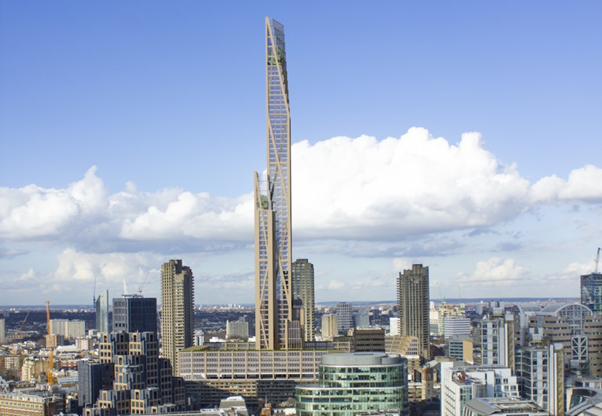TIMBER... skyscraper for London?
By Brad Foletta
 |
| Image source: Inhabitat |
London’s first timber skyscraper is a step closer to reality with conceptual plans presented by PLP Architecture and Cambridge University. The plans are for an 80-storey, 300 metre tall wooden building which it plans to incorporate within the Barbican Estate.
If built, the wooden structure would be the tallest of its kind in the world and the second tallest building in London after the Shard. In addition to the use of renewable materials, the skyscraper’s timber frame could also lock in 50,000 tonnes of carbon dioxide — equivalent to the annual carbon emissions of 5,000 Londoners.
The proposed one-million-square-foot mixed-use skyscraper and mid-rise terraces would create over 1,000 new residential units.
The use of timber as a structural material in tall buildings is an area of emerging interest for its variety of potential benefits; the most obvious being that it is a renewable resource, unlike prevailing construction methods which use concrete and steel. The research is also investigating other potential benefits, such as reduced costs and improved construction timescales, increased fire resistance, and significant reduction in the overall weight of buildings.
The world's tallest wooden building to date is a 14-storey apartment block in Bergen, Norway, but there are several more in the pipeline.
For more on this article, click below:
http://inhabitat.com/worlds-tallest-timber-skyscraper-proposed-for-london/
Also, check out this article on wooden skyscrapers from the Urban Developer.
If built, the wooden structure would be the tallest of its kind in the world and the second tallest building in London after the Shard. In addition to the use of renewable materials, the skyscraper’s timber frame could also lock in 50,000 tonnes of carbon dioxide — equivalent to the annual carbon emissions of 5,000 Londoners.
The proposed one-million-square-foot mixed-use skyscraper and mid-rise terraces would create over 1,000 new residential units.
The use of timber as a structural material in tall buildings is an area of emerging interest for its variety of potential benefits; the most obvious being that it is a renewable resource, unlike prevailing construction methods which use concrete and steel. The research is also investigating other potential benefits, such as reduced costs and improved construction timescales, increased fire resistance, and significant reduction in the overall weight of buildings.
The world's tallest wooden building to date is a 14-storey apartment block in Bergen, Norway, but there are several more in the pipeline.
For more on this article, click below:
http://inhabitat.com/worlds-tallest-timber-skyscraper-proposed-for-london/
Also, check out this article on wooden skyscrapers from the Urban Developer.


Every time I needed to contact my property manager, he's always very professional and on top of things. I have so many great things to say about the company for Luxury Real Estate in dove mountain which I hired.
ReplyDelete